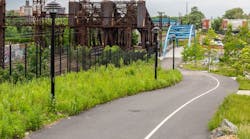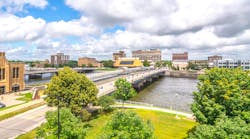When it comes to drainage infrastructure, if the installed product becomes a public concern, it is safe to say something was done incorrectly. Buried structures should perform reliably, underground, where they ought to remain a non-issue and unseen for generations.
With sustainability becoming an increasing topic of concern and goal in today’s political and social environments, the products and systems that compose drainage structures should not be exempt. However, sustainability of infrastructure cannot be achieved if the products and systems are not resilient enough to handle the changing physical environment resulting from climate change.
Traditionally, sustainability is categorized by societal, environmental and economic tenants. These categories encompass what is referred to as “the three pillars of sustainability,” “the triple bottom line,” or “people, planet, and profit.” When it comes to infrastructure, it is important that every transportation, housing, power, water, waste and drainage system be constructed with all three aspects of sustainability as a top priority. Doing so will ensure a bright future for generations to come.
To promote a sustainable infrastructure, we need to consider various products and how they are made and used over the course of their lifetime. There is no man-made material that does not utilize the earth’s resources in some fashion or another – either through the energy needed to form the material, the water and oxygen needed to produce it, or even the natural resources themselves. Thus, it is important that when we produce a product and install it, it is done properly the first time, allowing it to last for generations.
Resilience is a Key to Sustainability
One key consideration for developing sustainable infrastructure is the role of resilience. Resilience can be defined as “the ability of a system to resist failure, limit impacts, and rapidly return to service after a disruptive event.” Simply put, if sustainability is limiting the impact that a system has on the surrounding environment, then resilience is limiting the impact that the surrounding environment has on a system. Resiliency is a means to the end goal of achieving sustainability.
Within the last decade, the physical environment has changed significantly. Flooding and fire events have increased by about 150% when compared to the previous decade. Because of this, we need to take into consideration if the resiliency of infrastructure is enough to endure these significant events and minimize any possible disturbances they could bring upon society. These “events” only become “disasters” when the infrastructure is not resilient enough to sustain its function through these occurrences.
A reliable and resilient material is concrete, and it is also the most widely used building material. Throughout the centuries concrete has been a trusted, well studied and well understood material. It can be versatile, durable, and hold numerous innate resilient properties that help it to resist threats that commonly affect our infrastructure.
Preventative Resilience is Crucial
The term resilient can imply either the ability to withstand an extreme event, or the ability to recover from an event. Which definition is most appropriate when it comes to our nation’s infrastructure? A survey of civil engineering and construction students revealed that of the four components of community resilience: 1) Prevention, 2) Mitigation, 3) Response and 4) Recovery; “prevention” had significantly more “Very High” ratings than any of the three other components.(1) These engineers of tomorrow are keenly aware they may not have the time, or resources, to allow an inconvenience that they will have to come back and fix later.
Most of the country’s major infrastructure was designed in the 1960s (3). Much of it had a design life of 50 years or less, with the assumption that it would be replaced at the end of its service life. How easy has it been to get the money to replace it? Getting the new Infrastructure Investment and Jobs Act (IIJA) passed to provide additional funding was a monumental task, and even the IIJA does not provide sufficient funds for what is needed. If a system’s resiliency is designed to be dependent on future generations paying for recovery methods after an extreme event, how likely is it the money will be available?
Instead, infrastructure designed with a focus on increased life-span will provide a better outcome. According to a report published by the New World Bank and the Global Facility for Disaster Reduction and Recovery, $1 invested in more resilient infrastructure would result in a $4 long-term benefit over the expected life of the infrastructure(2). Put another way: those who invest in preventative resilience will receive long-term benefits and cost savings.
We must keep in mind that developing an infrastructure that is sustainable within the context of our changing physical environment affects the economic and societal sustainability of a region. Insufficient consideration of today’s environmental concerns can lead to devastating failures that may require a significant amount of funds for recovery activities. In many areas this can trap people into a cycle of loss and recovery simply because appropriate standards that provide preventative resilience are not utilized.
When it comes to drainage infrastructure, reinforced concrete pipe (RCP) has been a staple of resilient communities for well over 100 years. There are notable resilient features of RCP that are inherent to the product itself. The heavy weight of concrete reduces the risk of flotation or washout, and it is not easily moved by rapid water or floating debris. Additionally, concrete as a material is inherently non-flammable and does not melt, so even direct exposure to flame or heat during a wildfire event poses no risk to the pipe’s performance. As time goes on and mixtures improve, engineering advances, and components become even more sustainable, RCP will only become a more sustainable choice.
Concrete pipe has remained a resilient, sustainable and mostly unnoticed element of America’s drainage infrastructure. With the effects of climate change, and the increase in extreme events, going unnoticed is perhaps a drainage pipe’s greatest attribute.
REFERENCES
1. “Infrastructure and Community Resilience”, GeoStrata, April/May 2022, Published by the Geo-Institute and the American Society of Civil Engineers
2. Hallegate, S., Rentschler, J., & Rozenberg, J. (2019), Lifelines: The Resilient Infrastructure Opportunity. (Sustainable Infrastructure). Washington, D.C.:World Bank
3. Council on Foreign Relations, “The State of U.S. Infrastructure”, James McBride and Anshu Siripurapu, November 8, 2021, www.cfr.org/backgrounder/state-us-infrastructure,






